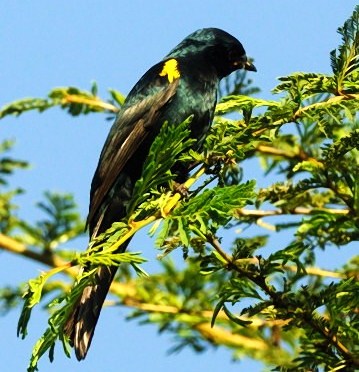Campephaga flava
 |
| Photo by Loutjie Steenberg (Internet Bird Collection) |
Common name:
black cuckooshrike (en); lagarteiro-preto (pt); échenilleur à épaulettes jaunes (fr); oruguero negro africano (es); kuckuckswürger (de)
Taxonomy:
Order Passeriformes
Family Campephagidae
Range:
This African species occurs south of the equator from southern Sudan, Kenya and the D.R. Congo down to southern Africa.
Size:
The black cuckooshrike is 20-22 cm long and weighs 32 g.
Habitat:
This species generally favours broad-leaved mixed woodlands, also occurring along the edges of evergreen forest and in well-wooded gardens.
Diet:
They mainly eat insects, which they glean from leaves and branches. They are known to take Lepidoptera, Orthoptera and Hemiptera. They occasionally also eat fruits.
Breeding:
Black cuckooshrikes breed in September-February. The female builds the nest alone, a cup made of moss, lichens and old-man’s beard lichen Usnea bound together with spider webs, placed in a vertical fork of a tree branch, often high up in the tree. There the female lays 1-3 green eggs, which she incubates alone for 20 days while receiving food from the male. The chicks are fed by both adults but brooded only by the female, and fledge 20-23 days after hatching.
Conservation:
IUCN status – LC (Least Concern)
This species has an extremely large breeding range and is reported to be uncommon to locally common. The population is suspected to be stable in the absence of evidence for any declines or substantial threats.







